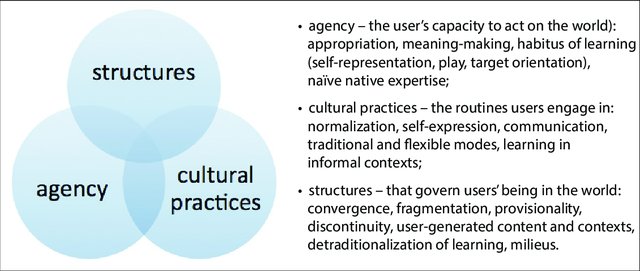See also Research Approach #1
For my analysis of Part 2 London in the '80s Indie Music, i.e. episodes 1-7 of my photo stories blog, as I started to use photo-story method I found that I naturally drew on the Giddens extended framework to describe what I was doing or seeing (shown in Figure above). The planned Grounded Study approach was put on hold. This resulted in my abstract (Cook, 2023), which was submitted for the Subcultures Network International Conference; this has been accepted. (See blog post on this.)
In parallel. Last year, in 2022, a drummer friend called Mary stood in for the regular guy at the jazz jams that I run every second Friday at Under the Edge Arts, Wotton-under-Edge (UK). Before the jam started, Mary went walkabout to get food and when she returned she commented that she found Wotton really interesting, with all the independent shops and lovely atmosphere, and would consider moving here. This got me thinking that I should dig into what makes Wotton a bit different, but in a good way, so I started to look into life living under the Cotswold Edge (I interpret the area involved very liberally).
For my interviews for the Living under the Cotswold Edge series (Moe, Martin and Carolyn's stories) I used a lightweight ethnographic interview approach, particularly descriptive and structural questions (see below). In the past I have used this approach in EC funded projects to gather user stories and look for patterns, and hence develop software for the workplace and learning (e.g. see my 2020 article in the British Journal of Educational Technology). This article from the respected ASHAWire in 2003 (home for American Journal of Audiology Research and various forums) is helpful in giving an overview of Ethnographic interviews:
"Responses to the descriptive questions will enable the interviewer to discover what is important to clients or their families. As interviewers listen to answers to descriptive questions, they begin to hear words or issues repeated. These words or issues represent important categories of knowledge. The interviewer wants to understand the relationships that exist among these categories. Nine relationships can capture the majority of the relationships that exist in people’s lives (see sidebar, below right, for examples of each type of structural question). For example, Sarah frequently mentioned being “overtaxed.” The interviewer then asked structural questions to explore Sarah’s concept of being overtaxed. “What kinds of things do you do when you are feeling overtaxed?” “What are the reasons you are overtaxed?” “What are ways to keep from being overtaxed?” ".
Above taken from https://leader.pubs.asha.org/doi/10.1044/leader.FTR3.08082003.4, my bold
It is the opposite of say a TV interview, where leading questions guide the response. Here you are using the interviewee as an 'informant', you want to tease out what they know or what is important to them. The technique comes from anthropology.

